Download the PDF version of this report by clicking here.
Key Insights
- In Q2 2022, Livepeer network usage remained flat after the previous quarter’s record high, with over 33 million minutes of transcoded video.
- Node operator revenue dropped 15% in ETH terms (down 59% in USD terms), due to stagnating demand and lower transcoding prices for end users.
- Revenue from LPT staking rewards grew 7% (down 68% in USD terms), while token inflation stayed relatively constant around 0.026% per day.
- The core team is focused on supporting the development of Web3 apps to supplement current usage which predominantly comes from Web2-facilitated apps.
- Livepeer is expanding its services beyond transcoding and aims to become the video infrastructure and service provider for both Web3 and traditional apps.

A Primer on Livepeer
Building a Twitch-like live video streaming app is expensive. A major cost driver is converting live streams into viewable formats, based on a user’s bandwidth and device. This process is called transcoding and is required every time a video is streamed on a user’s smartphone or laptop.
Livepeer is an open and permissionless marketplace for decentralized video infrastructure. It aims to reduce the cost of video transcoding by 10x. It does so by allowing anyone to contribute their computer’s resources — CPU, GPU, and bandwidth — for transcoding. As a result, market participants compete on price. This ultimately drives down transcoding costs for the end users — apps and developers.
Within Livepeer’s decentralized network, node operators (‘’orchestrators”) and transcoders deliver transcoded video content to end users. Transcoding jobs are routed to the most effective node operators. If one node operator goes down, the transcoding job is automatically re-routed to another node operator. This process makes the transcoding service reliable.
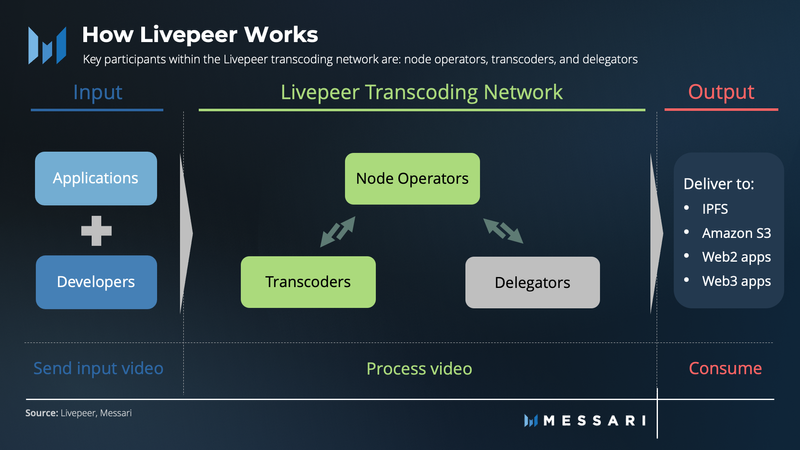
Staking LPT – the native Livepeer token – ties this process together. The more LPT a node operator stakes, the more work it can perform on the network. Transcoders earn ETH fees by providing computing resources to node operators. Delegators also contribute by staking tokens towards effective node operators, thus helping secure the Livepeer network. Staking is rewarded with a portion of ETH fees and newly minted LPT.
Performance Analysis
Demand for Livepeer services comes from apps and developers in need of video transcoding services. Livepeer’s network usage can thus be gauged by how many minutes of video are transcoded.
Network Usage
Both Q2 2022 and Q1 2022 saw a record of over 33 million minutes of transcoded video content. This stabilization shows a healthy demand, given that Livepeer’s network usage achieved all-time-highs in each of the six previous quarters from Q1 2021 to Q2 2022.

A potential explanation for usage stagnation is the core team’s focus on supporting the development of new Web3 apps on Livepeer. Livepeer Studio — formerly known as Livepeer Video Services — has been acting as a bridge between the decentralized transcoding network and Web2 apps requiring video services. For example, Korkuma, a live shopping video tool for brands, benefits from Livepeer’s reduced fees for its business operations. Livepeer Studio is presently facilitating the vast majority of network usage via such partnerships.
In Q2 2022, instead of further allocating resources to onboarding Web2 clients, Livepeer Studio shifted its focus to fund and help develop Web3-native video-enabled projects. This translated to 100+ new projects building on Livepeer in H1 2022. The rationale behind this focus shift is to plant the seeds for future Web3 video transcoding demand.
Future demand may also come from onboarding existing Web3-enabled video apps, e.g., video NFT minting or token-gated access streaming platforms. Livepeer aims to further increase its protocol usage for 4k video and expand into other verticals, as discussed in the “Roadmap: Beyond Transcoding” section.
Network Revenue
Livepeer’s network revenue consists of demand-side and supply-side revenue. On the one hand, node operators ensure that the transcoding supply meets the demand of apps. Demand-side revenue comprises ETH fees accrued from transcoding services. On the other hand, delegators help route work to node operators by committing stake to them. While supply-side revenue consists of staking rewards and a portion of network fees, the majority of the rewards currently come from staking.
Transcoding Revenue (Demand-Side)
Fees from transcoding services are paid to node operators in ETH and distributed to transcoders, node operators, and delegators. As node operators stake more LPT, they increase their likelihood of receiving more transcoding work, which would result in them earning more transcoding fees. When delegators assign their stake to node operators, it acts as a quality assurance mechanism that routes work to effective nodes. Should a node operator miss transcoding jobs or perform poorly, delegators may choose to route their stake elsewhere.
Livepeer transcoding fee revenue decreased 15% in ETH terms in Q2 2022. In USD terms, this corresponded to a 59% drop. Given that network usage stayed flat, this decrease in transcoding fee revenue corresponds to a drop in the price paid by end users. Similar to Ethereum gas fees, Livepeer operates as an open fee market set by node operators. Stagnating demand will potentially lead to decreased fees, as node operators compete to attract transcoding work.

Transcoding fee revenue is relatively insignificant compared to staking reward revenue (as discussed below). Like other Web3 infrastructure protocols, Livepeer subsidizes its node operators with inflationary rewards. This subsidization enables the Livepeer protocol to compete with existing transcoding providers like Amazon and Google, by reducing the cost of live video transcoding by 10x.
As per Messari’s recent analysis of Web3 infrastructure revenue, Livepeer’s transcoding fee revenue can be evaluated according to its total addressable market. While this market is still relatively small, transcoding revenue is growing proportionally with usage and transcoding fees. As transcoding fees continue to fall, the upward trend in the number of transcoded minutes needs to continue in the coming quarters. Livepeer is well-positioned in a market with significant upside potential, provided that usage continues to increase.
Staking Revenue (Supply-Side)
To provide transcoding services on the Livepeer network, node operators must stake LPT. In turn, Livepeer distributes rewards in LPT to node operators and delegators. Staking reward revenue in LPT terms increased 7% in Q2 2022 but was down 68% in USD terms.
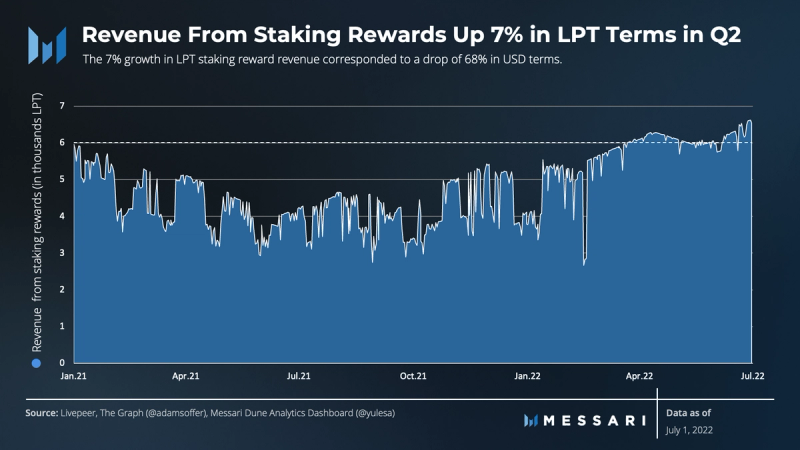
LPT staking reward issuance is dynamic: it’s based on the participation rate, which is the percentage of the circulating supply that is staked. If the participation rate falls below 50% in a given round, LPT inflation increases by 0.00005%, incentivizing token holders to commit stake to the Livepeer network. Conversely, if participation passes 50%, inflation decreases by 0.00005%.
Staking Overview
Our Q1 2022 quarterly report found that the Livepeer network had managed to incentivize network participants to approach the target equilibrium of 50% participation level. The participation rate briefly crossed 50% in May 2022 yet stabilized at slightly below 50% in June, resulting in daily inflationary issuance staying relatively constant around 0.026%.
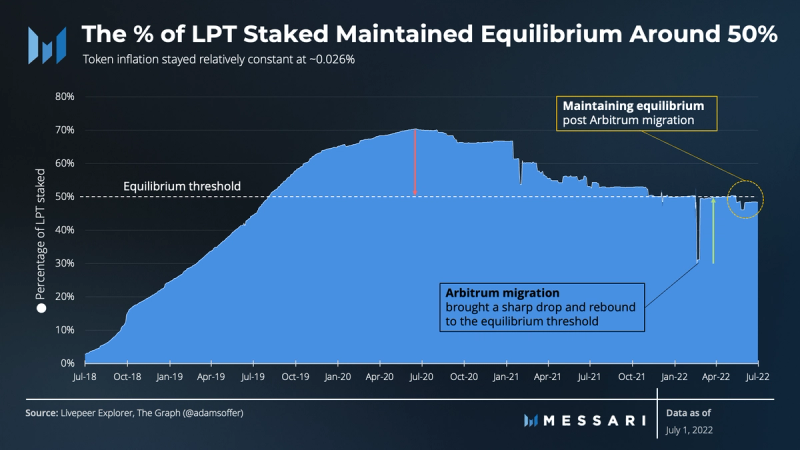
As of Q2 2022, 99 node operators facilitate transcoding on the Livepeer network. The node operator limit is currently set at 100. Although this low limit may help existing node operators maintain profitability in the short term, there exists a tradeoff. The limit could exclude newer node operators with less stake, increasing centralization of the network. Ongoing discussions focus on increasing the node operator limit.
To help secure the network, delegators stake their LPT with node operators. As of the end of Q2 2022, there are a total 4,290 delegators and 99 node operators staking LPT on the network. As of July 1, 2022, the top 16 node operators by LPT stake account for 80% of the total LPT staked. Future decentralization efforts thus need to focus on a more uniform distribution of staked LPT on the network.
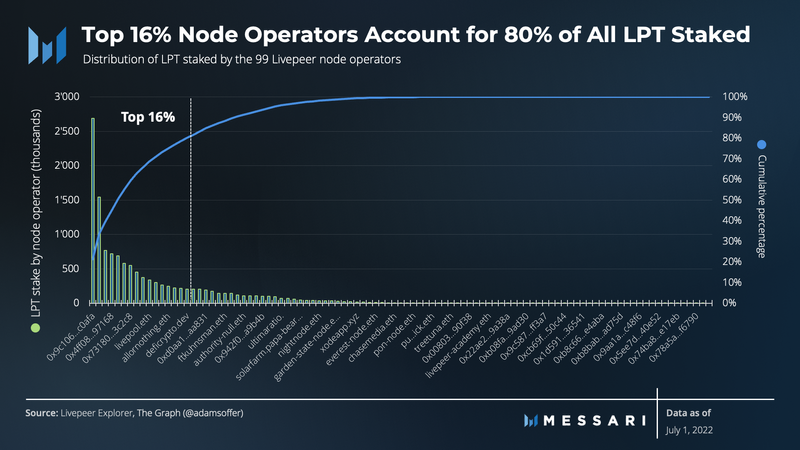
In addition, out of the 4,290 delegators, 297 have more than 1,000 staked LPT in Q2 2022. This number has increased from 245 in Q1 2022, 263 in Q4 2021, and 261 in Q3 2021. When plotting the distribution of stake by delegators, only 1.2% of delegators (i.e., 51 of the 4,290) account for 80% of the total staked LPT.
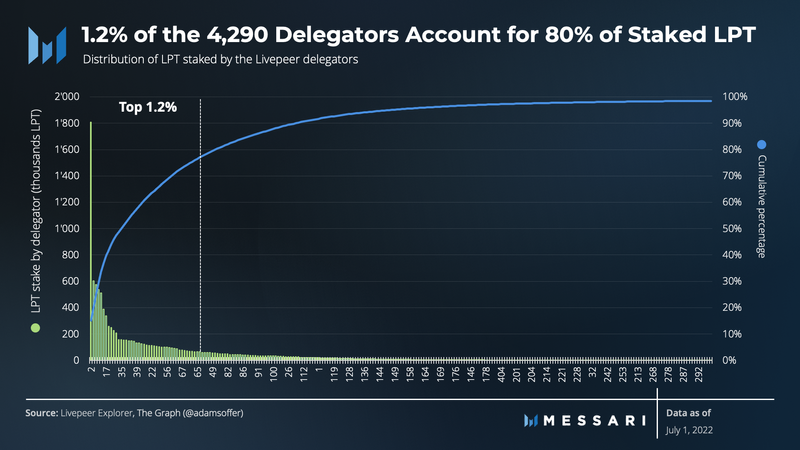
Development Overview
Livepeer development activity showed strength in Q2 2022. Livepeer attended nearly every major Web3 hackathon and released a number of development toolkits for builders leveraging the network. Additionally, Livepeer distributed grants from the $250,000 grants program for Q2. While Q1 2022 saw a total of 72 projects building Livepeer-enabled apps and services, Q2 2022 added an additional 36 projects to that roster. Of these new projects, 37% integrated directly with the network, rather than leveraging Livepeer Studio’s broadcasting services.
Overall development activity saw two spikes in Q2 2022. First, April marked several hackathons and grants awarded, along with a new video NFT minting SDK showcased at the Livepeer Community Summit. The second peak in May appears to correspond to NFT Berlin.
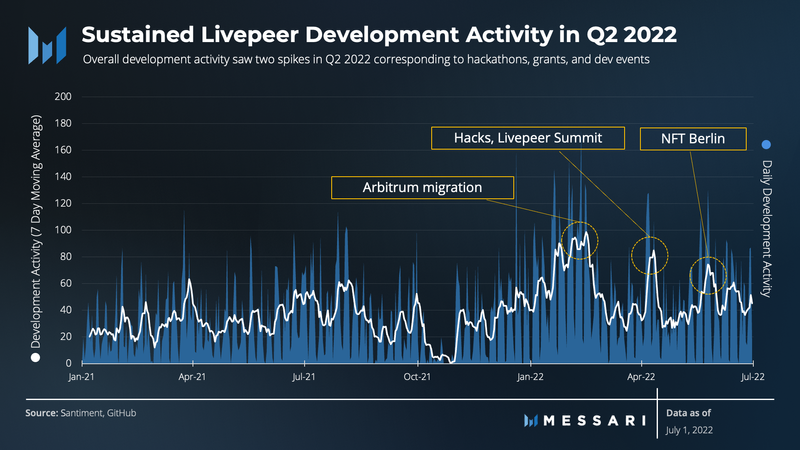
Notable projects under development include Iris, a Web3 social creator platform built on Lens Protocol, and Web 3 Edi, a broadcasting educational platform. Further funding of $250,000 is expected each quarter moving forward, as per Livepeer’s Grants Tracker. As these projects grow into maturity, Livepeer network usage is expected to increase.
Qualitative Analysis
Livepeer Ecosystem: Notable Events
Upgraded Livepeer Explorer
The Livepeer Explorer allows for visualizing network activity and delegating tokens. The data is indexed and served by The Graph through a subgraph built by Livepeer. The Livepeer Explorer had a facelift in Q2 to expand usage, performance metrics, and optimize stake routing across node operators. The upgrade includes a visualization of delegators, inflation, and fees. Delegators are now presented with additional information on node operators including yield estimates and percent of jobs completed. Further enhancements include network latency, fee claims, token redelegations, and transcoding requests.

Source: Livepeer Explorer
Rebrands and Partnerships
Livepeer Video Services has traditionally serviced the majority of network demand by bridging Web2 applications requiring transcoding services to the decentralized network facilitated by fiat payments. In Q2 2022, Livepeer Video Services rebranded to Livepeer Studio and shifted focus towards Web3 adoption. While the company still offers payment rails for Web2 apps to access the Livepeer network, its current focus is on building infrastructure and tools for Web3 builders leveraging video content.
A prominent example is Livepeer Studio’s partnership with Polygon which launched a video NFT Minting SDK. More advanced users can use Livepeer’s VoD API to export video assets to IPFS prior to minting NFTs. Furthermore, Livepeer Studio is working with the Web3 social network Lens Protocol. While the details of this partnership are unknown, Livepeer is set to supply critical infrastructure for the video content that will play a major role in Web3 social.
Roadmap
The Q2 2022 roadmap included several technical and product upgrades. Notably, the Livepeer Explorer got a face-lift. Upgrades focused on refining the transcoding process and on exploring opportunities beyond transcoding are still expected. These include the expansion of the Fast Verification Procedure, which streamlines transcoding verification by easing the validation burden on apps.
Additional roadmap items in development include a workflow for improving transcoding latency and fee market upgrades for node operator selection including greater fee visibility. Further efforts to increase the node operator limit above 100 are under discussion.
Web3 Video Focus
With the rise of Web3 video-focused apps in recent quarters, Livepeer is leaning into the opportunity to be the video platform for Web3 apps, beyond just transcoding. This includes a focus on on-chain specific features enabled by Web3 within the video world. In the NFT space, Livepeer and design partners at hackathons have looked into minting uploaded video clips, clipping live video segments into NFTs, and representing live stream channels as NFTs.
Access control is another promising area. Creator communities could have token-gated access to both live streams and on-demand video, and DAOs could release content or control who joins their video-based events.
These capabilities exist beyond just Ethereum and Arbitrum as well. The Polygon partnership serves as the first example of Livepeer’s commitment to support video in other development ecosystems.
Beyond Transcoding
In H2 2022, Livepeer plans to expand its video service offering to include additional GPU use cases beyond video transcoding.
Firstly, Livepeer plans to introduce scene classification and object recognition capabilities. Through scene classification algorithms, Livepeer node operators will be able to classify and tag specific types of content — such as violent or adult content — and help with content moderation. Object recognition capabilities will include features like automatically recognizing in-video entities, making them clickable, and enhancing them with metadata. These features can be useful for e-commerce experiences by providing content consumers with in-video links to purchase items featured in streams.
Moreover, Livepeer’s additional future use cases include: video compositing (combining various videos into one); fingerprinting (using NFTs to prove ownership); and song title recognition (mitigating potential copyright infringement).
Furthermore, Livepeer Founder Doug Petkanics recently discussed his vision of offering services over and above infrastructure for video broadcasting. Livepeer has thus far successfully connected a reliable and scalable network of video infrastructure providers. This model may well be reproducible outside of the video broadcasting stack to cover a wider range of services including video ingestion, content delivery, and even generic compute capabilities. As the network matures, services may grow to include real-time communication, low-latency video conferencing, generic computation on data streams, and interactive video, to name a few.
Closing Summary
Livepeer is expanding its services beyond transcoding as it aims to become the video infrastructure and services layer for both Web3 and traditional apps. Livepeer is on a progressive decentralization path, both from a technical and ecosystem perspective. Its core team has recently announced intentions to adopt a DAO-like structure.
Demand may remain flat until new Web3 apps breakout beyond prototype phase. However, important steps are being made, namely the sustained development efforts and the record token staking on the network. At the same time, to ensure a resilient ecosystem, Livepeer needs to accrue more revenue from transcoding services as opposed to rewards. It also needs to continue its efforts towards a more uniform token holding distribution.
As the Livepeer network onboards more demand and expands its network of nodes and services, it welcomes the possibility of becoming a prominent infrastructure player for the video broadcasting stack, ingest and delivery layer, and eventually the general compute industry.
Looking to dive deeper? Subscribe to Messari Pro. Messari Pro memberships provide access to daily crypto news and insights, exclusive long-form daily research, advanced screener, charting & watchlist features, and access to curated sets of charts and metrics. Learn more at messari.io/pro
This report was commissioned by Livepeer, a member of Protocol Services. All content was produced independently by the author(s) and does not necessarily reflect the opinions of Messari, Inc. or the organization that requested the report. Paid membership in Protocol Services does not influence editorial decision or content. Author(s) may hold cryptocurrencies named in this report.
Crypto projects can commission independent research through Protocol Services. For more details or to join the program, contact ps@messari.io.
This report is meant for informational purposes only. It is not meant to serve as investment advice. You should conduct your own research, and consult an independent financial, tax, or legal advisor before making any investment decisions. Past performance of any asset is not indicative of future results. Please see our terms of use for more information.
















